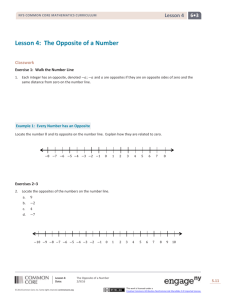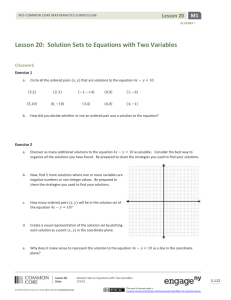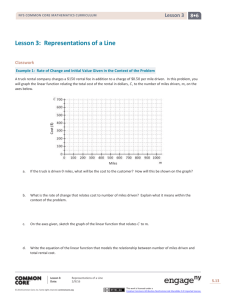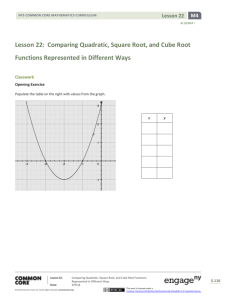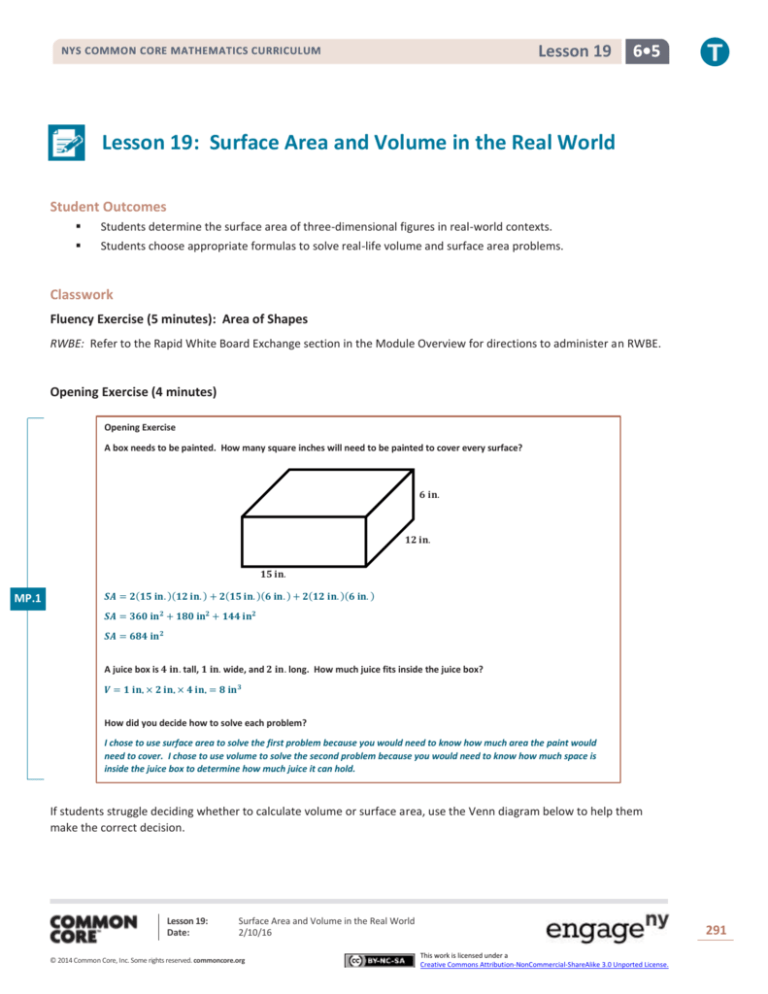
Lesson 19
NYS COMMON CORE MATHEMATICS CURRICULUM
6•5
Lesson 19: Surface Area and Volume in the Real World
Student Outcomes
Students determine the surface area of three-dimensional figures in real-world contexts.
Students choose appropriate formulas to solve real-life volume and surface area problems.
Classwork
Fluency Exercise (5 minutes): Area of Shapes
RWBE: Refer to the Rapid White Board Exchange section in the Module Overview for directions to administer an RWBE.
Opening Exercise (4 minutes)
Opening Exercise
A box needs to be painted. How many square inches will need to be painted to cover every surface?
𝟔 𝐢𝐧.
𝟏𝟐 𝐢𝐧.
𝟏𝟓 𝐢𝐧.
MP.1
𝑺𝑨 = 𝟐(𝟏𝟓 𝐢𝐧. )(𝟏𝟐 𝐢𝐧. ) + 𝟐(𝟏𝟓 𝐢𝐧. )(𝟔 𝐢𝐧. ) + 𝟐(𝟏𝟐 𝐢𝐧. )(𝟔 𝐢𝐧. )
𝑺𝑨 = 𝟑𝟔𝟎 𝐢𝐧𝟐 + 𝟏𝟖𝟎 𝐢𝐧𝟐 + 𝟏𝟒𝟒 𝐢𝐧𝟐
𝑺𝑨 = 𝟔𝟖𝟒 𝐢𝐧𝟐
A juice box is 𝟒 𝐢𝐧. tall, 𝟏 𝐢𝐧. wide, and 𝟐 𝐢𝐧. long. How much juice fits inside the juice box?
𝑽 = 𝟏 𝐢𝐧. × 𝟐 𝐢𝐧. × 𝟒 𝐢𝐧. = 𝟖 𝐢𝐧𝟑
How did you decide how to solve each problem?
I chose to use surface area to solve the first problem because you would need to know how much area the paint would
need to cover. I chose to use volume to solve the second problem because you would need to know how much space is
inside the juice box to determine how much juice it can hold.
If students struggle deciding whether to calculate volume or surface area, use the Venn diagram below to help them
make the correct decision.
Lesson 19:
Date:
Surface Area and Volume in the Real World
2/10/16
© 2014 Common Core, Inc. Some rights reserved. commoncore.org
291
This work is licensed under a
Creative Commons Attribution-NonCommercial-ShareAlike 3.0 Unported License.
Lesson 19
NYS COMMON CORE MATHEMATICS CURRICULUM
6•5
Discussion (5 minutes)
Students need to be able to recognize the difference between volume and surface area. As a class, complete the Venn
diagram below so students have a reference when completing the application problems.
Discussion
Volume
Measures space inside
Includes only space
needed to fill inside
Is measured in cubic units
Surface Area
A way to
measure
space
figures
Measures outside surface
Includes all faces
Is measured in square units
Can be measured using a
net
Example 1 (5 minutes)
Work through the word problem below with students. Students should be leading the discussion in order for them to be
prepared to complete the exercises.
Example 1
Vincent put logs in the shape of a rectangular prism. He built this rectangular prism of logs outside his house. However, it
is supposed to snow, and Vincent wants to buy a cover so the logs will stay dry. If the pile of logs creates a rectangular
prism with these measurements:
𝟑𝟑 𝐜𝐦 long, 𝟏𝟐 𝐜𝐦 wide, and 𝟒𝟖 𝐜𝐦 high,
what is the minimum amount of material needed to make a cover for the wood pile?
We need to find the size of the cover for the logs, so we need to calculate
the surface area. In order to find the surface area, we need to know the
dimensions of the pile of logs.
Why do we need to find the surface area and not the volume?
Scaffolding:
Where do we start?
We want to know the size of the cover Vincent wants to buy. If we
calculated volume, we would not have the information Vincent needs
when he goes shopping for a cover.
What are the dimensions of the pile of logs?
The length is 33 cm, the width is 12 cm, and the height is 48 cm.
Lesson 19:
Date:
Add to the poster or
handout made in the
previous lesson showing
that long represents
length, wide represents
width, and high represents
height.
Later, students will have to
recognize that deep also
represents height.
Therefore, this vocabulary
word should also be added
to the poster.
Surface Area and Volume in the Real World
2/10/16
© 2014 Common Core, Inc. Some rights reserved. commoncore.org
292
This work is licensed under a
Creative Commons Attribution-NonCommercial-ShareAlike 3.0 Unported License.
Lesson 19
NYS COMMON CORE MATHEMATICS CURRICULUM
6•5
How do we calculate the surface area to determine the size of the cover?
We can use the surface area formula for a rectangular prism.
𝑆𝐴 = 2(33 cm)(12 cm) + 2(33 cm)(48 cm) + 2(12 cm)(48 cm)
𝑆𝐴 = 792 cm2 + 3168 cm2 + 1152 cm2
𝑆𝐴 = 5112 cm2
What is different about this problem from other surface area problems of rectangular prisms you have
encountered? How does this change the answer?
If Vincent just wants to cover the wood to keep it dry, he does not need to cover the bottom of the pile
of logs. Therefore, the cover can be smaller.
How can we change our answer to find the exact size of the cover Vincent needs?
We know the area of the bottom of the pile of logs has the dimensions 33 cm and 12 cm. We can
calculate the area and subtract this area from the total surface area.
The area of the bottom of the pile of firewood is 396 cm2 ; therefore, the total surface area of the cover
would need to be 5112 cm2 − 396 cm2 = 4716 cm2 .
Exercises 1–6 (17 minutes)
Students complete the volume and surface area problems in small groups.
Exercises 1–6
Use your knowledge of volume and surface area to answer each problem.
1.
Quincy Place wants to add a pool to the neighborhood. When determining the budget, Quincy Place determined
that it would also be able to install a baby pool that requires less than 𝟏𝟓 cubic feet of water. Quincy Place has
three different models of a baby pool to choose from.
Choice One: 𝟓 𝐟𝐞𝐞𝐭 × 𝟓 𝐟𝐞𝐞𝐭 × 𝟏 𝐟𝐨𝐨𝐭
Choice Two: 𝟒 𝐟𝐞𝐞𝐭 × 𝟑 𝐟𝐞𝐞𝐭 × 𝟏 𝐟𝐨𝐨𝐭
Choice Three: 𝟒 𝐟𝐞𝐞𝐭 × 𝟐 𝐟𝐞𝐞𝐭 × 𝟐 𝐟𝐞𝐞𝐭
Which of these choices is best for the baby pool? Why are the others not good choices?
Choice One Volume: 𝟓 𝐟𝐭. × 𝟓 𝐟𝐭. × 𝟏 𝐟𝐭. = 𝟐𝟓 𝐜𝐮𝐛𝐢𝐜 𝐟𝐞𝐞𝐭
Choice Two Volume: 𝟒 𝐟𝐭. × 𝟑 𝐟𝐭. × 𝟏 𝐟𝐭. = 𝟏𝟐 𝐜𝐮𝐛𝐢𝐜 𝐟𝐞𝐞𝐭
MP.1
Choice Three Volume: 𝟒 𝐟𝐭. × 𝟐 𝐟𝐭. × 𝟐 𝐟𝐭. = 𝟏𝟔 𝐜𝐮𝐛𝐢𝐜 𝐟𝐞𝐞𝐭
Choice Two is within the budget because it holds less than 𝟏𝟓 𝐜𝐮𝐛𝐢𝐜 𝐟𝐞𝐞𝐭 of water. The other two choices do not
work because they require too much water, and Quincy Place will not be able to afford the amount of water it takes
to fill the baby pool.
2.
A packaging firm has been hired to create a box for baby blocks. The firm was hired because it could save money by
creating a box using the least amount of material. The packaging firm knows that the volume of the box must be
𝟏𝟖 𝐜𝐦𝟑 .
a.
What are possible dimensions for the box if the volume must be exactly 𝟏𝟖 𝐜𝐦𝟑?
Choice 1: 𝟏 𝐜𝐦 × 𝟏 𝐜𝐦 × 𝟏𝟖 𝐜𝐦
Choice 2: 𝟏 𝐜𝐦 × 𝟐 𝐜𝐦 × 𝟗 𝐜𝐦
Choice 3: 𝟏 𝐜𝐦 × 𝟑 𝐜𝐦 × 𝟔 𝐜𝐦
Choice 4: 𝟐 𝐜𝐦 × 𝟑 𝐜𝐦 × 𝟑 𝐜𝐦
Lesson 19:
Date:
Surface Area and Volume in the Real World
2/10/16
© 2014 Common Core, Inc. Some rights reserved. commoncore.org
293
This work is licensed under a
Creative Commons Attribution-NonCommercial-ShareAlike 3.0 Unported License.
Lesson 19
NYS COMMON CORE MATHEMATICS CURRICULUM
b.
6•5
Which set of dimensions should the packaging firm choose in order to use the least amount of material?
Explain.
Choice 1: 𝑺𝑨 = 𝟐(𝟏 𝐜𝐦)(𝟏 𝐜𝐦) + 𝟐(𝟏 𝐜𝐦)(𝟏𝟖 𝐜𝐦) + 𝟐(𝟏 𝐜𝐦)(𝟏𝟖 𝐜𝐦) = 𝟕𝟒 𝐜𝐦𝟐
Choice 2: 𝑺𝑨 = 𝟐(𝟏 𝐜𝐦)(𝟐 𝐜𝐦) + 𝟐(𝟏 𝐜𝐦)(𝟗 𝐜𝐦) + 𝟐(𝟐 𝐜𝐦)(𝟗 𝐜𝐦) = 𝟓𝟖 𝐜𝐦𝟐
Choice 3: 𝑺𝑨 = 𝟐(𝟏 𝐜𝐦)(𝟑 𝐜𝐦) + 𝟐(𝟏 𝐜𝐦)(𝟔 𝐜𝐦) + 𝟐(𝟑 𝐜𝐦)(𝟔 𝐜𝐦) = 𝟓𝟒 𝐜𝐦𝟐
Choice 4: 𝑺𝑨 = 𝟐(𝟐 𝐜𝐦)(𝟑 𝐜𝐦) + 𝟐(𝟐 𝐜𝐦)(𝟑 𝐜𝐦) + 𝟐(𝟑 𝐜𝐦)(𝟑 𝐜𝐦) = 𝟒𝟐 𝐜𝐦𝟐
The packaging firm should choose Choice 4 because it requires the least amount of material. In order to find
the amount of material needed to create a box, the packaging firm would have to calculate the surface area
of each box. The box with the smallest surface area requires the least amount of material.
3.
A gift has the dimensions of 𝟓𝟎 𝐜𝐦 × 𝟑𝟓 𝐜𝐦 × 𝟓 𝐜𝐦. You have wrapping paper with dimensions of 𝟕𝟓 𝐜𝐦 ×
𝟔𝟎 𝐜𝐦. Do you have enough wrapping paper to wrap the gift? Why or why not?
Surface Area of the Present: 𝑺𝑨 = 𝟐(𝟓𝟎 𝐜𝐦)(𝟑𝟓 𝐜𝐦) + 𝟐(𝟓𝟎 𝐜𝐦)(𝟓 𝐜𝐦) + 𝟐(𝟑𝟓 𝐜𝐦)(𝟓 𝐜𝐦) =
𝟑𝟓𝟎𝟎 𝐜𝐦𝟐 + 𝟓𝟎𝟎 𝐜𝐦𝟐 + 𝟑𝟓𝟎 𝐜𝐦𝟐 = 𝟒𝟑𝟓𝟎 𝐜𝐦𝟐
Area of Wrapping Paper: 𝑨 = 𝟕𝟓 𝐜𝐦 × 𝟔𝟎 𝐜𝐦 = 𝟒, 𝟓𝟎𝟎 𝐜𝐦𝟐
I do have enough paper to wrap the present because the present requires 𝟒, 𝟑𝟓𝟎 𝐬𝐪𝐮𝐚𝐫𝐞 𝐜𝐞𝐧𝐭𝐢𝐦𝐞𝐭𝐞𝐫𝐬 of paper,
and I have 𝟒, 𝟓𝟎𝟎 𝐬𝐪𝐮𝐚𝐫𝐞 𝐜𝐞𝐧𝐭𝐢𝐦𝐞𝐭𝐞𝐫𝐬 of wrapping paper.
MP.1
4.
Tony bought a flat rate box from the post office to send a gift to his mother for Mother’s Day. The dimensions of the
medium size box are 𝟏𝟒 𝐢𝐧𝐜𝐡𝐞𝐬 × 𝟏𝟐 𝐢𝐧𝐜𝐡𝐞𝐬 × 𝟑. 𝟓 𝐢𝐧𝐜𝐡𝐞𝐬. What is the volume of the largest gift he can send to
his mother?
Volume of the Box: 𝟏𝟒 𝐢𝐧. × 𝟏𝟐 𝐢𝐧. × 𝟑. 𝟓 𝐢𝐧. = 𝟓𝟖𝟖 𝐢𝐧𝟑
Tony would have 𝟓𝟖𝟖 𝐜𝐮𝐛𝐢𝐜 𝐢𝐧𝐜𝐡𝐞𝐬 of space to fill with a gift for his mother.
5.
A cereal company wants to change the shape of its cereal box in order to attract the attention of shoppers. The
original cereal box has dimensions of 𝟖 𝐢𝐧𝐜𝐡𝐞𝐬 × 𝟑 𝐢𝐧𝐜𝐡𝐞𝐬 × 𝟏𝟏 𝐢𝐧𝐜𝐡𝐞𝐬. The new box the cereal company is
thinking of would have dimensions of 𝟏𝟎 𝐢𝐧𝐜𝐡𝐞𝐬 × 𝟏𝟎 𝐢𝐧𝐜𝐡𝐞𝐬 × 𝟑 𝐢𝐧𝐜𝐡𝐞𝐬.
a.
Which box holds more cereal?
Volume of Original Box: 𝑽 = 𝟖 𝐢𝐧. × 𝟑 𝐢𝐧. × 𝟏𝟏 𝐢𝐧. = 𝟐𝟔𝟒 𝐢𝐧𝟑
Volume of New Box: 𝑽 = 𝟏𝟎 𝐢𝐧. × 𝟏𝟎 𝐢𝐧. × 𝟑 𝐢𝐧. = 𝟑𝟎𝟎 𝐢𝐧𝟑
The new box holds more cereal because it has a larger volume.
b.
Which box requires more material to make?
Surface Area of Original Box: 𝑺𝑨 = 𝟐(𝟖 𝐢𝐧. )(𝟑 𝐢𝐧. ) + 𝟐(𝟖 𝐢𝐧. )(𝟏𝟏 𝐢𝐧. ) + 𝟐(𝟑 𝐢𝐧. )(𝟏𝟏 𝐢𝐧. ) =
𝟒𝟖 𝐢𝐧𝟐 + 𝟏𝟕𝟔 𝐢𝐧𝟐 + 𝟔𝟔 𝐢𝐧𝟐 = 𝟐𝟗𝟎 𝐢𝐧𝟐
Surface Area of New Box: 𝑺𝑨 = 𝟐(𝟏𝟎 𝐢𝐧. )(𝟏𝟎 𝐢𝐧. ) + 𝟐(𝟏𝟎 𝐢𝐧. )(𝟑 𝐢𝐧. ) + 𝟐(𝟏𝟎 𝐢𝐧. )(𝟑 𝐢𝐧. ) =
𝟐𝟎𝟎 𝐢𝐧𝟐 + 𝟔𝟎 𝐢𝐧𝟐 + 𝟔𝟎 𝐢𝐧𝟐 = 𝟑𝟐𝟎 𝐢𝐧𝟐
The new box requires more material than the original box because the new box has a larger surface area.
Lesson 19:
Date:
Surface Area and Volume in the Real World
2/10/16
© 2014 Common Core, Inc. Some rights reserved. commoncore.org
294
This work is licensed under a
Creative Commons Attribution-NonCommercial-ShareAlike 3.0 Unported License.
Lesson 19
NYS COMMON CORE MATHEMATICS CURRICULUM
6.
6•5
Cinema theaters created a new popcorn box in the shape of a rectangular prism. The new popcorn box has a length
of 𝟔 inches, a width of 𝟑. 𝟓 inches, and a height of 𝟑. 𝟓 inches but does not include a lid.
Scaffolding:
English language learners may
not be familiar with the term
lid. Provide an illustration or
demonstration.
𝟑. 𝟓 𝐢𝐧.
𝟑. 𝟓 𝐢𝐧.
𝟔 𝐢𝐧.
a.
MP.1
How much material is needed to create the box?
Surface Area of the Box: 𝑺𝑨 = 𝟐(𝟔 𝐢𝐧. )(𝟑. 𝟓 𝐢𝐧. ) + 𝟐(𝟔 𝐢𝐧. )(𝟑. 𝟓 𝐢𝐧. ) + 𝟐(𝟑. 𝟓 𝐢𝐧. )(𝟑. 𝟓 𝐢𝐧. ) =
𝟒𝟐 𝐢𝐧𝟐 + 𝟒𝟐 𝐢𝐧𝟐 + 𝟐𝟒. 𝟓 𝐢𝐧𝟐 = 𝟏𝟎𝟖. 𝟓 𝐢𝐧𝟐
The box does not have a lid, so we have to subtract the area of the lid from the surface area.
Area of Lid: 𝟔 𝐢𝐧. × 𝟑. 𝟓 𝐢𝐧. = 𝟐𝟏 𝐢𝐧𝟐
Total Surface Area: 𝟏𝟎𝟖. 𝟓 𝐢𝐧𝟐 − 𝟐𝟏 𝐢𝐧𝟐 = 𝟖𝟕. 𝟓 𝐢𝐧𝟐
𝟖𝟕. 𝟓 𝐬𝐪𝐮𝐚𝐫𝐞 𝐢𝐧𝐜𝐡𝐞𝐬 of material is needed to create the new popcorn box.
b.
How much popcorn does the box hold?
Volume of the Box: 𝑽 = 𝟔 𝐢𝐧. × 𝟑. 𝟓 𝐢𝐧. × 𝟑. 𝟓 𝐢𝐧. = 𝟕𝟑. 𝟓 𝐢𝐧𝟑
Closing (4 minutes)
Is it possible for two containers having the same volume to have different surface areas? Explain.
Yes, it is possible to have two containers to have the same volume but different surface areas. This was
the case in Exercise 2. All four boxes would hold the same amount of baby blocks (same volume), but
required a different amount of material (surface area) to create the box.
If you want to create an open box with dimensions 3 inches × 4 inches × 5 inches, which face should be the
base if you want to minimize the amount of material you use?
The face with dimensions 4 inches × 5 inches should be the base because that face would have the
largest area.
If students have a hard time understanding an open box, use a shoe box to demonstrate the difference between a closed
box and an open box.
Exit Ticket (5 minutes)
Lesson 19:
Date:
Surface Area and Volume in the Real World
2/10/16
© 2014 Common Core, Inc. Some rights reserved. commoncore.org
295
This work is licensed under a
Creative Commons Attribution-NonCommercial-ShareAlike 3.0 Unported License.
Lesson 19
NYS COMMON CORE MATHEMATICS CURRICULUM
Name
6•5
Date
Lesson 19: Surface Area and Volume in the Real World
Exit Ticket
Solve the word problem below.
Kelly has a rectangular fish aquarium with an open top that measures 18 inches long, 8 inches wide, and 12 inches tall.
a.
What is the maximum amount of water in cubic inches the aquarium can hold?
b.
If Kelly wanted to put a protective covering on the four glass walls of the aquarium, how big does the cover
have to be?
Lesson 19:
Date:
Surface Area and Volume in the Real World
2/10/16
© 2014 Common Core, Inc. Some rights reserved. commoncore.org
296
This work is licensed under a
Creative Commons Attribution-NonCommercial-ShareAlike 3.0 Unported License.
Lesson 19
NYS COMMON CORE MATHEMATICS CURRICULUM
6•5
Exit Ticket Sample Solutions
Solve the word problem below.
Kelly has a rectangular fish aquarium that measures 𝟏𝟖 inches long, 𝟖 inches wide, and 𝟏𝟐 inches tall.
a.
What is the maximum amount of water the aquarium can hold?
Volume of the Aquarium: 𝑽 = 𝟏𝟖 𝐢𝐧. × 𝟖 𝐢𝐧. × 𝟏𝟐 𝐢𝐧. = 𝟏𝟕𝟐𝟖 𝐢𝐧𝟑
The maximum amount of water the aquarium can hold is 𝟏, 𝟕𝟐𝟖 𝐜𝐮𝐛𝐢𝐜 𝐢𝐧𝐜𝐡𝐞𝐬.
b.
If Kelly wanted to put a protective covering on the four glass walls of the aquarium, how big does the cover
have to be?
Surface Area of the Aquarium: 𝑺𝑨 = 𝟐(𝟏𝟖 𝐢𝐧. )(𝟖 𝐢𝐧. ) + 𝟐(𝟏𝟖 𝐢𝐧. )(𝟏𝟐 𝐢𝐧. ) + 𝟐(𝟖 𝐢𝐧. )(𝟏𝟐 𝐢𝐧. ) =
𝟐𝟖𝟖 𝐢𝐧𝟐 + 𝟒𝟑𝟐 𝐢𝐧𝟐 + 𝟏𝟗𝟐 𝐢𝐧𝟐 = 𝟗𝟏𝟐 𝐢𝐧𝟐
We only need to cover the four glass walls, so we can subtract the area of both the top and bottom of the
aquarium.
Area of Top: 𝑨 = 𝟏𝟖 𝐢𝐧. × 𝟖 𝐢𝐧. = 𝟏𝟒𝟒 𝐢𝐧𝟐
Area of Bottom: 𝑨 = 𝟏𝟖 𝐢𝐧. × 𝟖 𝐢𝐧. = 𝟏𝟒𝟒 𝐢𝐧𝟐
Surface Area of the Four Walls: 𝑺𝑨 = 𝟗𝟏𝟐 𝐢𝐧𝟐 − 𝟏𝟒𝟒 𝐢𝐧𝟐 − 𝟏𝟒𝟒 𝐢𝐧𝟐 = 𝟔𝟐𝟒 𝐢𝐧𝟐
Kelly would need 𝟔𝟐𝟒 𝐢𝐧𝟐 to cover the four walls of the aquarium.
Problem Set Sample Solutions
Solve each problem below.
1.
Dante built a wooden, cubic toy box for his son. Each side of the box measures 𝟐 feet.
a.
How many square feet of wood did he use to build the box?
Surface Area of the Box: 𝑺𝑨 = 𝟔(𝟐 𝐟𝐭)𝟐 = 𝟔(𝟒 𝐟𝐭 𝟐 ) = 𝟐𝟒 𝐟𝐭 𝟐
Dante would need 𝟐𝟒 𝐬𝐪𝐮𝐚𝐫𝐞 𝐟𝐞𝐞𝐭 of wood to build the box.
b.
How many cubic feet of toys will the box hold?
Volume of the Box: 𝑽 = 𝟐 𝐟𝐭. × 𝟐 𝐟𝐭. × 𝟐 𝐟𝐭. = 𝟖 𝐟𝐭 𝟑
The toy box would hold 𝟖 𝐜𝐮𝐛𝐢𝐜 𝐟𝐞𝐞𝐭 of toys.
2.
A company that manufactures gift boxes wants to know how many different sized boxes having a volume of 𝟓𝟎
cubic centimeters it can make if the dimensions must be whole centimeters.
a.
List all the possible whole number dimensions for the box.
Choice One: 𝟏 𝐜𝐦 × 𝟏 𝐜𝐦 × 𝟓𝟎 𝐜𝐦
Choice Two: 𝟏 𝐜𝐦 × 𝟐 𝐜𝐦 × 𝟐𝟓 𝐜𝐦
Choice Three: 𝟏 𝐜𝐦 × 𝟓 𝐜𝐦 × 𝟏𝟎 𝐜𝐦
Choice Four: 𝟐 𝐜𝐦 × 𝟓 𝐜𝐦 × 𝟓 𝐜𝐦
Lesson 19:
Date:
Surface Area and Volume in the Real World
2/10/16
© 2014 Common Core, Inc. Some rights reserved. commoncore.org
297
This work is licensed under a
Creative Commons Attribution-NonCommercial-ShareAlike 3.0 Unported License.
Lesson 19
NYS COMMON CORE MATHEMATICS CURRICULUM
b.
6•5
Which possibility requires the least amount of material to make?
Choice One: 𝑺𝑨 = 𝟐(𝟏 𝐜𝐦)(𝟏 𝐜𝐦) + 𝟐(𝟏 𝐜𝐦)(𝟓𝟎 𝐜𝐦) + 𝟐(𝟏 𝐜𝐦)(𝟓𝟎 𝐜𝐦) = 𝟐 𝐜𝐦𝟐 + 𝟏𝟎𝟎 𝐜𝐦𝟐 +
𝟏𝟎𝟎 𝐜𝐦𝟐 = 𝟐𝟎𝟐 𝐜𝐦𝟐
Choice Two: 𝑺𝑨 = 𝟐(𝟏 𝐜𝐦)(𝟐 𝐜𝐦) + 𝟐(𝟏 𝐜𝐦)(𝟐𝟓 𝐜𝐦) + 𝟐(𝟐 𝐜𝐦)(𝟐𝟓 𝐜𝐦) = 𝟒 𝐜𝐦𝟐 + 𝟓𝟎 𝐜𝐦𝟐 +
𝟏𝟎𝟎 𝐜𝐦𝟐 = 𝟏𝟓𝟒 𝐜𝐦𝟐
Choice Three: 𝑺𝑨 = 𝟐(𝟏 𝐜𝐦)(𝟓 𝐜𝐦) + 𝟐(𝟏 𝐜𝐦)(𝟏𝟎 𝐜𝐦) + 𝟐(𝟓 𝐜𝐦)(𝟏𝟎 𝐜𝐦) = 𝟏𝟎 𝐜𝐦𝟐 + 𝟐𝟎 𝐜𝐦𝟐 +
𝟏𝟎𝟎 𝐜𝐦𝟐 = 𝟏𝟑𝟎 𝐜𝐦𝟐
Choice Four: 𝑺𝑨 = 𝟐(𝟐 𝐜𝐦)(𝟓 𝐜𝐦) + 𝟐(𝟐 𝐜𝐦)(𝟓 𝐜𝐦) + 𝟐(𝟓 𝐜𝐦)(𝟓 𝐜𝐦) = 𝟐𝟎 𝐜𝐦𝟐 + 𝟐𝟎 𝐜𝐦𝟐 + 𝟓𝟎 𝐜𝐦𝟐 =
𝟗𝟎 𝐜𝐦𝟐
Choice Four requires the least amount of material because it has the smallest surface area.
c.
Which box would you recommend the company use? Why?
I would recommend the company use the box with dimensions of 𝟐 𝐜𝐦 × 𝟓 𝐜𝐦 × 𝟓 𝐜𝐦 (Choice Four) because
it requires the least amount of material to make; so, it would cost the company the least amount of money to
make.
3.
A rectangular box of rice is shown below. How many cubic inches of rice can fit inside?
𝟏𝟓
𝟔
Volume of the Rice Box: 𝑽 = 𝟏𝟓
4.
𝟏
𝐢𝐧.
𝟑
𝟏
𝐢𝐧.
𝟑
𝟕
𝟐
𝐢𝐧.
𝟑
𝟏
𝟐
𝟏
𝟐𝟎𝟏𝟎𝟐 𝟑
𝟏𝟒 𝟑
𝐢𝐧. × 𝟕 𝐢𝐧. × 𝟔 𝐢𝐧. =
𝐢𝐧 = 𝟕𝟒𝟒
𝐢𝐧
𝟑
𝟑
𝟑
𝟐𝟕
𝟐𝟕
The Mars Cereal Company has two different cereal boxes for Mars Cereal. The large box is 𝟖 inches wide, 𝟏𝟏 inches
high, and 𝟑 inches deep. The small box is 𝟔 inches wide, 𝟏𝟎 inches high, and 𝟐. 𝟓 inches deep.
a.
How much more cardboard is needed to make the large box than the small box?
Surface Area of the Large Box: 𝑺𝑨 = 𝟐(𝟖 𝐢𝐧. )(𝟏𝟏 𝐢𝐧. ) + 𝟐(𝟖 𝐢𝐧. )(𝟑 𝐢𝐧. ) + 𝟐(𝟏𝟏 𝐢𝐧. )(𝟑 𝐢𝐧. ) = 𝟏𝟕𝟔 𝐢𝐧𝟐 +
𝟒𝟖 𝐢𝐧𝟐 + 𝟔𝟔 𝐢𝐧𝟐 = 𝟐𝟗𝟎 𝐢𝐧𝟐
Surface Area of the Small Box: 𝑺𝑨 = 𝟐(𝟔 𝐢𝐧. )(𝟏𝟎 𝐢𝐧. ) + 𝟐(𝟔 𝐢𝐧. )(𝟐. 𝟓 𝐢𝐧. ) + 𝟐(𝟏𝟎 𝐢𝐧. )(𝟐. 𝟓 𝐢𝐧. ) =
𝟏𝟐𝟎 𝐢𝐧𝟐 + 𝟑𝟎 𝐢𝐧𝟐 + 𝟓𝟎 𝐢𝐧𝟐 = 𝟐𝟎𝟎 𝐢𝐧𝟐
Difference: 𝟐𝟗𝟎 𝐢𝐧𝟐 − 𝟐𝟎𝟎 𝐢𝐧𝟐 = 𝟗𝟎 𝐢𝐧𝟐
The large box requires 𝟗𝟎 𝐬𝐪𝐮𝐚𝐫𝐞 𝐢𝐧𝐜𝐡𝐞𝐬 more material than the small box.
b.
How much more cereal does the large box hold than the small box?
Volume of the Large Box: 𝑽 = 𝟖 𝐢𝐧. × 𝟏𝟏 𝐢𝐧. × 𝟑 𝐢𝐧. = 𝟐𝟔𝟒 𝐢𝐧𝟑
Volume of the Small Box: 𝑽 = 𝟔 𝐢𝐧. × 𝟏𝟎 𝐢𝐧. × 𝟐. 𝟓 𝐢𝐧. = 𝟏𝟓𝟎 𝐢𝐧𝟑
Difference: 𝟐𝟔𝟒 𝐢𝐧𝟑 − 𝟏𝟓𝟎 𝐢𝐧𝟑 = 𝟏𝟏𝟒 𝐢𝐧𝟑
The large box holds 𝟏𝟏𝟒 𝐜𝐮𝐛𝐢𝐜 𝐢𝐧𝐜𝐡𝐞𝐬 more cereal than the small box.
Lesson 19:
Date:
Surface Area and Volume in the Real World
2/10/16
© 2014 Common Core, Inc. Some rights reserved. commoncore.org
298
This work is licensed under a
Creative Commons Attribution-NonCommercial-ShareAlike 3.0 Unported License.
Lesson 19
NYS COMMON CORE MATHEMATICS CURRICULUM
5.
6•5
A swimming pool is 𝟖 meters long, 𝟔 meters wide, and 𝟐 meters deep. The water-resistant paint needed for the
pool costs $𝟔 per square meter. How much will it cost to paint the pool?
a.
How many faces of the pool do you have to paint?
You will have to point 𝟓 faces.
b.
How much paint (in square meters) do you need to paint the pool?
𝑺𝑨 = 𝟐(𝟖 𝐦 × 𝟔 𝐦) + 𝟐(𝟖 𝐦 × 𝟐 𝐦) + 𝟐(𝟔 𝐦 × 𝟐 𝐦) = 𝟗𝟔 𝐦𝟐 + 𝟑𝟐 𝐦𝟐 + 𝟐𝟒 𝐦𝟐 = 𝟏𝟓𝟐 𝐦𝟐
Area of Top of Pool: 𝟖 𝐦 × 𝟔 𝐦 = 𝟒𝟖 𝐦𝟐
Total Paint Needed: 𝟏𝟓𝟐 𝐦𝟐 − 𝟒𝟖 𝐦𝟐 = 𝟏𝟎𝟒 𝐦𝟐
c.
How much will it cost to paint the pool?
𝟏𝟎𝟒 𝐦2 × $𝟔 = $𝟔𝟐𝟒
It will cost $𝟔𝟐𝟒 to paint the pool.
6.
Sam is in charge of filling a rectangular hole with cement. The hole is 𝟗 feet long, 𝟑 feet wide, and 𝟐 feet deep. How
much cement will Sam need?
𝑽 = 𝟗 𝐟𝐭. × 𝟑 𝐟𝐭. × 𝟐 𝐟𝐭. = 𝟓𝟒 𝐟𝐭 𝟑
Sam will need 𝟓𝟒 𝐜𝐮𝐛𝐢𝐜 𝐟𝐞𝐞𝐭 of cement to fill the hole.
7.
The volume of Box D subtracted from the volume of Box C is 𝟐𝟑. 𝟏𝟒 cubic centimeters. Box D has a volume of
𝟏𝟎. 𝟏𝟏𝟓 cubic centimeters.
a.
Let 𝑪 be the volume of Box C in cubic centimeters. Write an equation that could be used to determine the
volume of Box C.
𝑪 − 𝟏𝟎. 𝟏𝟏𝟓 𝐜𝐦𝟑 = 𝟐𝟑. 𝟏𝟒 𝐜𝐦𝟑
b.
Solve the equation to determine the volume of Box C.
𝑪 − 𝟏𝟎. 𝟏𝟏𝟓 𝐜𝐦𝟑 + 𝟏𝟎. 𝟏𝟏𝟓 𝐜𝐦𝟑 = 𝟐𝟑. 𝟏𝟒 𝐜𝐦𝟑 + 𝟏𝟎. 𝟏𝟏𝟓 𝐜𝐦𝟑
𝑪 = 𝟑𝟑. 𝟐𝟓𝟓 𝐜𝐦𝟑
c.
The volume of Box C is one-tenth the volume of another box, Box E. Let 𝑬 represent the volume of Box E in
cubic centimeters. Write an equation that could be used to determine the volume of Box E, using the result
from part (b).
𝟑𝟑. 𝟐𝟓𝟓 𝐜𝐦𝟑 =
d.
𝟏
𝑬
𝟏𝟎
Solve the equation to determine the volume of Box E.
𝟑𝟑. 𝟐𝟓𝟓 𝐜𝐦𝟑 ÷
𝟏
𝟏
𝟏
=
𝑬÷
𝟏𝟎 𝟏𝟎
𝟏𝟎
𝟑𝟑𝟐. 𝟓𝟓 𝐜𝐦𝟑 = 𝑬
Lesson 19:
Date:
Surface Area and Volume in the Real World
2/10/16
© 2014 Common Core, Inc. Some rights reserved. commoncore.org
299
This work is licensed under a
Creative Commons Attribution-NonCommercial-ShareAlike 3.0 Unported License.
Lesson 19
NYS COMMON CORE MATHEMATICS CURRICULUM
6•5
Area of Shapes
1.
8 ft.
𝑨 = 𝟖𝟎 𝐟𝐭 𝟐
10 ft.
2.
13 m
5m
𝑨 = 𝟑𝟎 𝐦𝟐
12 m
22 in.
3.
22 in.
𝑨 = 𝟒𝟖𝟒 𝐢𝐧𝟐
4.
𝑨 = 𝟏, 𝟎𝟐𝟗 𝐜𝐦𝟐
21 cm
49 cm
Lesson 19:
Date:
Surface Area and Volume in the Real World
2/10/16
© 2014 Common Core, Inc. Some rights reserved. commoncore.org
300
This work is licensed under a
Creative Commons Attribution-NonCommercial-ShareAlike 3.0 Unported License.
Lesson 19
NYS COMMON CORE MATHEMATICS CURRICULUM
6•5
5.
10 ft.
8 ft.
𝑨 = 𝟕𝟐 𝐟𝐭 𝟐
6 ft.
12 ft.
8 km
6.
13 km
13 km
12 km
𝑨 = 𝟏𝟓𝟔 𝐤𝐦𝟐
12 km
5 km
5 km
8 km
7.
𝑨 = 𝟏𝟏𝟎 𝐢𝐧𝟐
8 cm
8.
4 cm
8 cm
8 cm
4 cm
8 cm
8 cm
𝑨 = 𝟏𝟗𝟐 𝐜𝐦𝟐
4 cm
4 cm
8 cm
Lesson 19:
Date:
Surface Area and Volume in the Real World
2/10/16
© 2014 Common Core, Inc. Some rights reserved. commoncore.org
301
This work is licensed under a
Creative Commons Attribution-NonCommercial-ShareAlike 3.0 Unported License.
Lesson 19
NYS COMMON CORE MATHEMATICS CURRICULUM
6•5
9.
𝑨 = 𝟓𝟕𝟔 𝐦𝟐
48 m
36 m
16 m
10.
𝑨 = 𝟏, 𝟒𝟕𝟔 𝐟𝐭 𝟐
82 ft.
18 ft.
Lesson 19:
Date:
Surface Area and Volume in the Real World
2/10/16
© 2014 Common Core, Inc. Some rights reserved. commoncore.org
302
This work is licensed under a
Creative Commons Attribution-NonCommercial-ShareAlike 3.0 Unported License.



